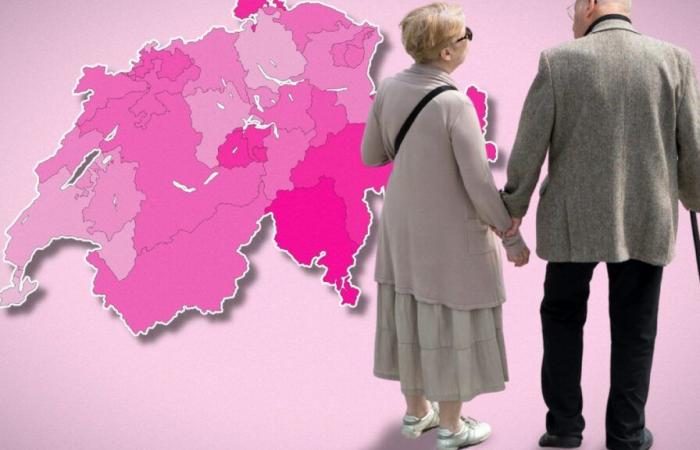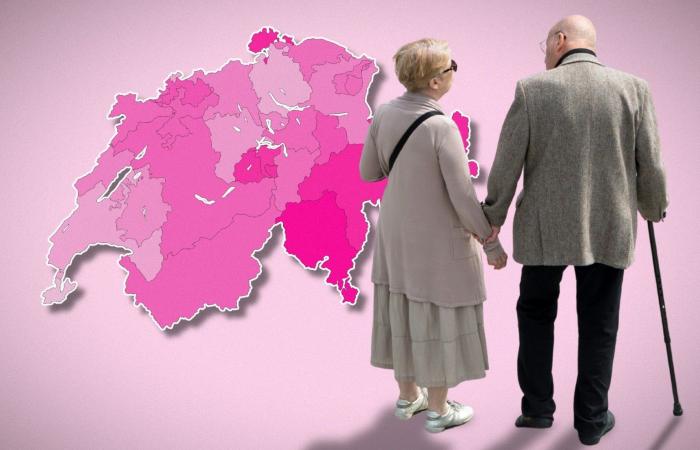
The aging of the population will increase in Switzerland, but not everywhere in the same way.Image: watson
The number of people over 65 will increase by 50% over the next 30 years in Switzerland. This “rapid and pronounced” demographic aging will be more important in certain cantons than in others, favored by internal migration.
05.05.2025, 05:3705.05.2025, 05:37

Follow me
If the Swiss population continues to evolve as it has done in recent years, the bar of ten million inhabitants will be crossed around 2040. This is what emerges from the demographic forecasts of the Federal Statistics Office (OFS), broadcast on April 15. In 2055, the Swiss population will reach 10.5 million people.
This growth will be accompanied by an aging “rapid and pronounced”, indicates the OFS. People aged 65 and over will increase by around 50% in the next 30 yearswhile the population as a whole should only increase by 15%. In 2055, seniors will represent 26% of the population, against a little less than 20% today.
Although global, this phenomenon will not impact Switzerland uniformly. SOF figures show that some regions will be more “older” than others. This is particularly the case of the Ticino cantons, Graubünden and Schaffhouse, where Seniors will represent more than 30% of the population In 2055.
Valais and Jura also display values higher than the national average (28.3%and 27.9%, respectively), while Geneva should win the country’s younger canton, the only one where the share of 65 and over will not exceed 21%. Vaud, Zurich and Basel-Ville will also be part of the regions least affected by this phenomenon.
In many cantons, such as Friborg, Lucerne and Argovie, the number of seniors should climb by more than 60%, while others have to expect less pronounced increases (+20% for Jura or Basel-city, for example), but always significantly higher than the increase in the global population.
young people leave the elderly cantons
The differences between the cantons will therefore be important. They are explained largely by internal migration, informs Philippe Wanner, demographer at the University of Geneva. The specialist stresses that fertility and life expectancy are similar throughout the country.
“The cantons displaying the weakest percentages of seniors, like Geneva and Zurich, attract young adults and repel retirees,” he explains. The influx of young people from older regions, such as Jura or Ticino, explains the youth of their populations.
“These cantons, and even more their urban centers, offer more professional opportunities than peripheral regions,” continues the demographer.
“Agriculture and industry occupy a relatively low place in the Swiss economy, which is organized around large agglomerations”
-Philippe Wanner
The centers also house universities, which attract students from all over the country, even from abroad, adds Philippe Wanner.
The elderly often follow a reverse trajectory. “The retirees who had come in the agglomerations to exercise their profession tend to reinstall themselves in their regions of origin, where life is calmer and the rents are more affordable,” illustrates Philippe Wanner.
The demographer stresses that differences can exist within the same canton. Vaud is an example, “he advances:” Lausanne and its agglomeration have a rather young population, but other parts of the canton, such as the big vaud, are quite older “.
“What matters is the proximity of urban and economic centers”
Philippe Wanner
Foreigners are younger
International migration plays a less important role in age differences between the cantons, notes Philippe Wanner. However, it helps to rejuvenate the population as a whole. “Immigrants tend to arrive young and leave at the time of retirement,” he summarizes.
“Within the Swiss population, people 65 or over are more numerous than young people (0–19 years). In the foreign population, it is the opposite, ”reports the OFS. “The 20-39 year olds make up the most important group of migrants”.
From 2035, according to the calculations of the Confederation, population growth will come exclusively from migration.
A longer life and fewer children
Several factors explain the aging of the population. Over the next few years, the most numerous generations in Baby-Boom will gradually enter the third age, which will increase the number of elderly people. This increase is also caused by the increase in life expectancy, which has doubled since the end of the 19th century. Conversely, fertility is at the bottom. From 3.7 children per woman at the beginning of the 20th century, we went to 1.4. However, for a population to renew itself, it would take an average of 2.1 children per woman. In this aging society, writes the OFS, the Swiss are older than foreigners, who rejuvenate the global population.










